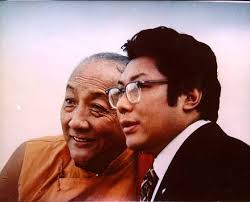It is the Shambhala view that every human being has a fundamental nature of goodness, warmth and intelligence. This nature can be cultivated through meditation, following ancient principles, and it can be further developed in daily life, so that it radiates out to family, friends, community and society.
In the course of our lives, this goodness, warmth and intelligence can easily become covered over by doubt, fear and egotism. We tend to fall into a kind of sleep or stupor, believing in the conditioning we have as the ultimate truth, and coming under the sway of fear. The journey of becoming fully human means seeing through fear and egotism, and waking up to our natural intelligence. It takes kindness—to ourselves and others—and courage, to wake up in this world.
The journey of awakening is known as the path of the warrior, as it requires the simple bravery to look directly at one’s own mind and heart. The essential tool for doing this is mindfulness meditation. As we continue on the Shambhala path, we learn many other practices, to help us break through the ancient crust of ego and awaken to the joy of fully living in this world. Awakening and opening, we discover the world to be naturally sacred—pure and full of beauty. We begin to see clearly the goodness and wisdom of others, and to feel compassion to help them in myriad ways.
Shambhala vision is rooted in the contemplative teachings of Buddhism, yet is a fresh expression of the spiritual journey for our time; it is available to practitioners of any tradition. Our lineage draws on the wisdom of the Kagyu and Nyingma schools of Tibetan Buddhism as inherited by founder of Shambhala, Chögyam Trungpa, and his son and spiritual heir, Sakyong Mipham. In the mid-1970s Chögyam Trungpa began to introduce teachings on Shambhala vision, based on his encounter with the Western world, and on the specific wisdom imparted from the Buddha to King Dawa Sangpo, the first sovereign of the legendary kingdom of Shambhala. This tradition teaches how to live in the secular world with courage and compassion.
Buddhism offers methods to clarify our mind, open our heart, and face the realities of human life, while the Shambhala Teachings offer practices for rousing our life force and connecting with the natural power and energy of the phenomenal world. The combination of these wisdom traditions offers a contemporary, effective spiritual path. Following it, we can reclaim our natural birthright of wisdom and compassion, and work with others to bring about the best in human society.
“In essence, the emphasis of the Buddhist path is to help us attain enlightenment, and the emphasis of the Shambhala path is help us create and maintain a good society. When we put these two together, we have the Shambhalian Buddhist view of enlightened society.” — Sakyong Mipham


